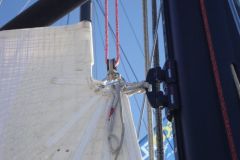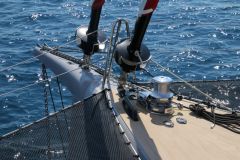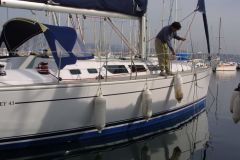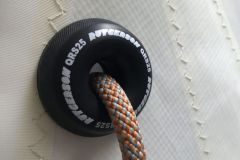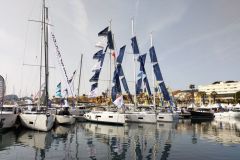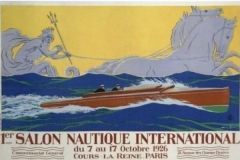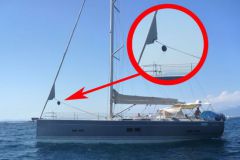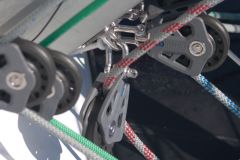The Nub is a small revolutionary friction pulley that will make some noise in the rigging worldâ?¦ Chez Bateaux.com we wondered about the revolutionary aspect of this small round ball of 16 grams, capable of pulling more than four tons at the break in static load, which is already a sacred revolution!
We met Louis Heckly. The son of the former president of the Yacht-Club de France who became a Swiss rigger at the head of Gréement Courant.

For the record, Louis Heckly and Bill Leclerc, preparers of the TP52 jousts or other Maxi circuit, brought their know-how to the designers of the Nub, Michel Sauget and François Angoulvant. Moreover, the two designers are not totally unknown to the racing world: Michel Sauget is from Delta Voiles in La Trinité and François Angoulvant is president of the Class 40 and equipped his Sabrosa 40 RC2 for his 3rd Rhum with some 18 Nub.
Let us return to our pulleyâeuros¦ To the question " How is the Nub revolutionary?" louis immediately responded " It is a small ring that provides the same service as a traditional pulley, but without a wheel turning on an axis, without ball bearings, without a mechanism. Contrary to a friction ring where you are obliged to have one of the ends passing through the ring, the rope is completely independent from the pulley. It is revolutionary because you have 2 notches that allow you to maintain the end. It is also revolutionary because of its price, its weight, the load it accepts, because on the market you will not find that and especially for the multiple uses that can be done on a boat. They are much more versatile than a friction ring and simpler than an opening pulley ."
Highlightsâeuros¦
He has a point, indeed. Today, no pulley or friction ring is capable of supporting a weight of 4.7 tons, especially with this size, weight and bulk (40 mm diameter).
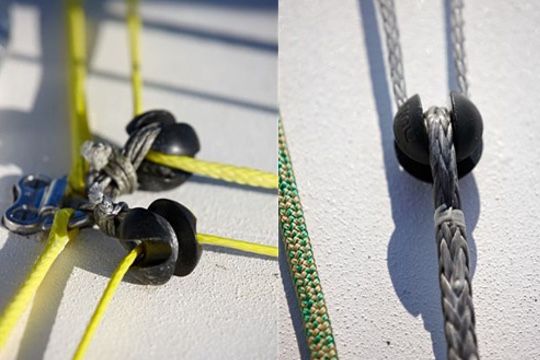
Another quality of the product is in its name " As it indicates it is a friction pulley, there is no bearing, therefore no loss in friction . However, it is still a pulley since it has the applications of 80% of the pulleys on board a boat today." explains Louis.
To continue the list of benefits, in the event that the Nub breaks, " the structural chain would never be broken because the rope running on one side would crush the rope holding the pulley on the other. So we would end up with rope against rope and typically the mast would not fall down and we would only have to replace this little ball by another one. The product is so cheap, that there is no reason not to have several on board.
Typically on any sailing boat, you have blocks at the foot of the mast that return the halyards. If one of those blocks were to have a weak spot, you take this little ball, put it on top of the halyard in place without going past the mast halyard or the block, do what's called a lashing, 3 turns with a Dyneema underneath, on the other side to hold it all together and you have a new mast foot block, in exactly 1 minute."
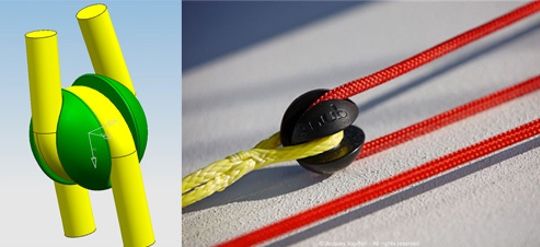
âeuros¦ And weak points
The Nub may be revolutionary, but it has a few flaws as Louis modestly acknowledges " The weak points are there, we are fully aware of them and we are ready to defend them ."
First, it is not recommended for use as a replacement for all types of pulleys, especially adjusting ones. " As a rigger, I feel that the Nub is not suitable for spinnaker blocks because tuning is ongoing and paramount to making proper adjustments in racing." Finally, its main weakness is that the Nub is still a friction pulley and therefore there may be throat systems that the team is working on.
In conclusionâeuros¦
Today, the Nub is adapted to racing boats " On 75% of racing boats, the maximum diameter of the ends is between 12 and 6 mm. This little ball fits". For cruise ships, " it is applicable as long as the diameter of the ropes corresponds to this product, which will obviously be offered in other diameters in the near future ." It has been tested on many racing boats in IRC, TP52... and the feedback has been conclusive.
Small and perfectly transportable, it fits anywhere on the boat and is perfectly adaptable to almost any halyard position on any boat: reefing, cascade hoist, backstay, vang, backstay, corner return (masthead block), barber or even as a cap-de-mons on standing rigging. And unlike friction rings, it can be rigged on a rope already under tensionâeuros¦
The Nub is available with a diameter of 12 mm, but the development of larger and smaller models is already underway. Made of nylon (about 30 different plastics have been tested on test benches and on the boats), the development of a wooden Nub for classic boats is already being studied. The question remains of the lifespan, which would be infinite, but the four men do not have enough hindsight to make estimates. Finally, at this price, even if it wears out, investing 39.90 euros for a new pair will not ruin you!
Finally, if you were to ask Louis to sell the Nub, he would probably tell you " It is 16 grams which is the 10 e of the weight of a normal bearing pulley, it's 40mm which is at least half the size, and it pulls loads significantly higher than what's on the market and most importantly, at a price that's unbeatable."
For the most curious among you, go to the Nautic of Paris on the stand of the Yacht-Club of France for the official presentation of the product.




